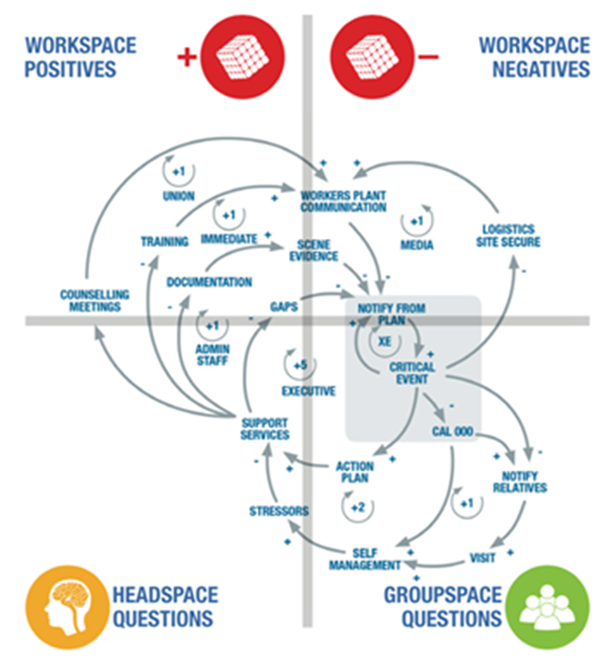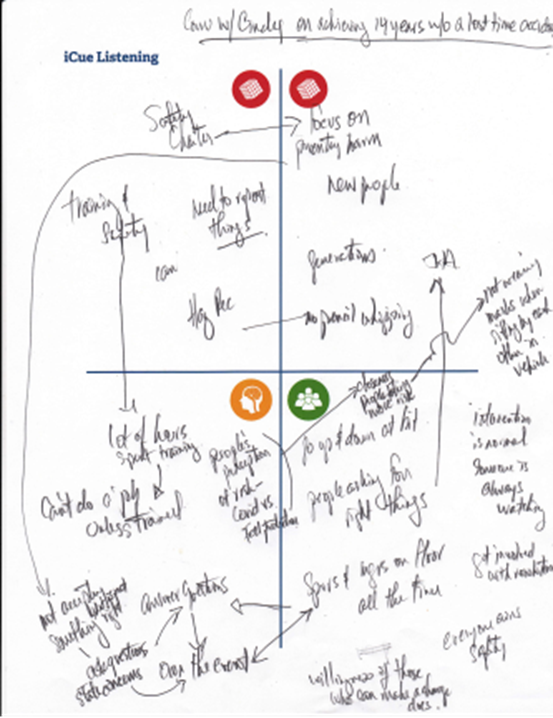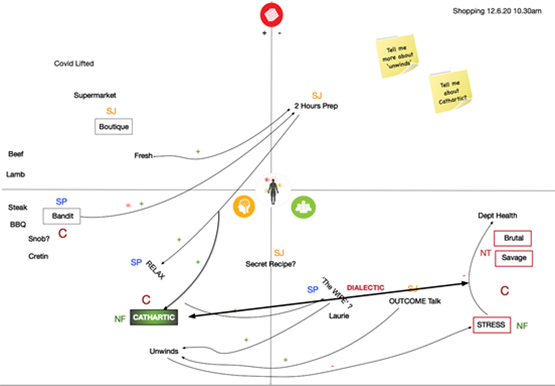Concept Mapping Risk iCue
The foundation of the Social Psychology of Risk (SPoR) is Socialitie and relationships. It is from this foundation that we learn to listen to others in order to help. Helping is not ‘telling’ and this poses one of the greatest challenges for an industry that loves to claim the brand ‘professional’. Helping facilitates bringing to Mind (https://safetyrisk.net/what-is-the-mind-of-safety/) much of what is hidden to ourselves. This ‘surfacing’ process helps others hear what they are unconsciously thinking and make such thinking conscious to them.
In SPoR we help people develop the skills of Socialitie and listening through a combination of two ‘tools’ – the iCue Listening Tool and Concept Mapping. This helps provide a structure for listening and guides the listener to ‘attend’ to ‘cues’ embedded in the conversation of the other. ‘Attending’ is widely accepted skill in counselling (https://counsellingtutor.com/basic-counselling-skills/the-meaning-of-attending/) that allows others to share in conversation. In an Introduction to SPoR such skills are learned as a starting point for tackling the complexities of risk.
SPoR is a very practical approach to risk and safety and focuses primarily on shifting skills from telling, policing and lecturing to listening, helping and facilitating learning.
iCue Listening is the foundation for Risky Conversations. In the training we model how to ‘map’ such listening so that at a later date (after practice) the model won’t be needed. Most of the people who undertake the introductory training report that they have never been taught how to listen nor what to listen for in risk (https://safetyrisk.net/online-studies-with-cllr/)..
The format for an iCue Conversation looks like Figure 1. iCue Conversations.
Figure 1. iCue Conversations.
The first thing we learn in iCue Conversations is iCue Listening. This is listening for risk cues on three levels: Workspace, Headspace and Groupspace (https://vimeo.com/143710374).
This very simple open structure allows people to hear what is happening without being shaped by a checklist or being sucked into the delusions of measurement. This proves to be a particularly helpful strategy in Incident Investigations and Risk Assessments.
All those who undertake the free online SPoR introduction (https://cllr.com.au/product/an-introduction-to-the-social-psychology-of-risk-unit-1-free-online-module/) report how this model creates insights they had not experienced before in their safety career (https://safetyrisk.net/online-studies-with-cllr/).
We are currently in the third wave of offering this free online module with the next offer starting in early November. You can register now to be in this group here: https://cllr.com.au/product/an-introduction-to-the-social-psychology-of-risk-unit-1-free-online-module/
The Introductory module runs over 8 Zoom sessions with practical homework, journaling and reflective practice. Here is an example of one of the participant conversations undertaken recently, see Figure 2. Participant Conversation.
Figure 2. Participant Conversation
The simple iCue model with some tutoring, enables just enough structure to get started in the process of learning to be a helper in tackling risk. An iCue is an intelligent cue that tells us what is ‘at risk’. Along with this tool we also help people learn effective questioning, Socratic questioning and iCue Questioning (https://safetyrisk.net/questioning-skills-and-investigations/). Again, all those from the safety industry in this workshop process report they have never been taught how to dialogue (https://safetyrisk.net/dialogue-dos-and-donts/) or listen.
Of course, concept mapping is not new but in this iCue Listening format it is. It is through iCue Listening that we adapt concept mapping to overlay the iCue framework and this allows us to see how physical, psychological and cultural layers of risk interact and relate to each other. Whilst the dominant approach of safety is on objects, hazards and telling, this tool teaches listening, helping and surfacing.
Once people have learned the foundations of iCue Listening then we progress onto using the tool for reflective analysis. You can see a model of this at Figure 3. iCue Reflective Analysis.
Figure 3. iCue Reflective Analysis.
It is in the iCue Reflective Analysis that we allow hidden aspects of thinking about risk to come to the surface. These are often the unconscious things and psychosocial things that orthodox risk assessments and investigations completely miss. Learning to ‘code’ of how to listen and reflect on iCues takes a number of weeks of practice and coaching.
Of course, none of these skills or the sense of these tools can be meaningful unless one undertakes a new approach to understanding risk and a new approach to enacting safety and this has to be learned. It also means that many of the common delusions and misconceptions of safety have to be unlearned. None of this exists in the AIHS BoK, WHS curriculum or in the safety industry globally.
If this is something you would like to learn you can sign up for the free online SPoR Introduction here: https://cllr.com.au/product/an-introduction-to-the-social-psychology-of-risk-unit-1-free-online-module/ or one of the many other online modules offered by CLLR (https://cllr.com.au/register-to-study/).






Do you have any thoughts? Please share them below